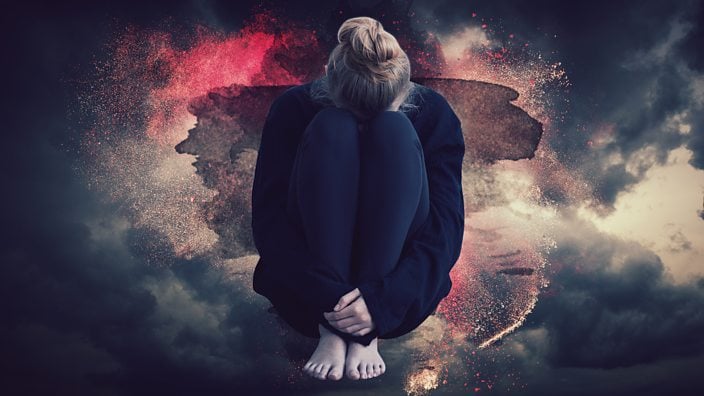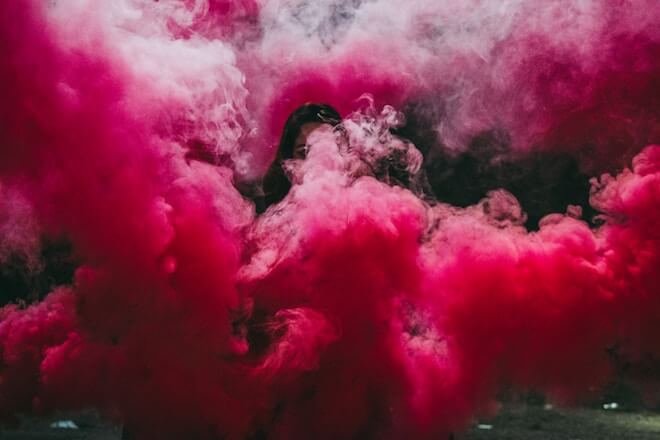MASSAGE FOR PREMENSTRUAL DYSPHORIC DISORDER (PMDD)

We’ve all heard of premenstrual syndrome (PMS) where various symptoms are caused by hormonal changes at certain times in the menstrual cycle. PMS affects around 40 million women, over 5 million of whom take some form of medication, but the symptoms usually fade once the period starts. Between 2.5% and 5% of those with PMS describe it as debilitating.
Up to 5% of women of childbearing age will suffer with premenstrual dysphoric disorder (PMDD), a severe form of premenstrual syndrome (PMS), which is characterised by severity of symptoms, not only physical but also behavioural/emotional. Depression and anxiety commonly present alongside PMDD, and normal functioning becomes difficult, hence why natural therapies are becoming more popular as a form of treatment.
CAUSES:-
No definitive cause for PMDD has been identified through research but suggested causes are:-
• Levels of serotonin, a mood enhancing endorphin, change throughout the menstrual cycle due to fluctuating hormone levels, and may explain the mood changes as some women may be more sensitive to these changes
• High stress levels mean high cortisol levels, which inhibits progesterone, potentially causing predominance of oestrogen following ovulation, as progesterone from the corpus luteum counterbalances the oestrogen levels. This oestrogen dominance would then also explain bloating and sugar cravings as oestrogen attracts fluid and causes salt retention and drops in blood sugar
• genetic predisposition in terms of sensitivity of receptors and efficiency of sex hormone signals within cells
DIAGNOSIS
• no single diagnostic test
• exclusion of other medical conditions that could explain both physical and emotional symptoms in sync with the menstrual cycle (differential diagnoses include anxiety disorders, thyroid dysfunction, substance abuse and the menopause)
• history of two consecutive menstrual cycles exhibiting luteal phase symptoms
• a daily diary of 2-3 months will help identify the frequency/severity of premenstrual symptoms, looking at the 3-5 most acute physical symptoms and the also the most acute emotional symptoms that arise in the 2 weeks prior to menstruation. Each symptom will be rated on a scale of 0 -10 (0 indicating no symptom; 10 indicating the most severe).

SYMPTOMS
The symptoms of PMDD will interfere with relationships and work.
EMOTIONAL/BEHAVIOURAL
• antisocial behaviour
• depression
• uncontrollable crying spells/feelings of sadness
• panic attacks
• poor concentration
• anxiety
• persistent anger
• irritability
• feeling out of control
• thoughts of suicide
• mood swings
• lack of interest in daily activities and relationships
PHYSICAL
• headaches/migraines
• fluid retention
• abdominal cramping
• fatigue
• food cravings/binge eating
• joint and muscular pain
• bloating
• breast tenderness
• insomnia
TREATMENT
• MEDICATION:-
-SSRI ANTIDEPRESSANTS - (selective serotonin reuptake inhibitors) alter serotonin levels in the brain (Sertraline, Fluoxetine, Paroxetine HCI) and have shown improvements in 60-70% of patients.
- NON-STEROIDAL ANTI INFLAMMATORIES – (Ibuprofen, Naproxen, Aspirin) to ease cramps, headaches, breast tenderness, muscle/joint pain
- GnRH AGONISTS – (leuprolide) can suppress ovulation and treat unmanageable PMDD, but not ideal for long term use due to irreversible bone loss
- HORMONAL THERAPY- Combined oral contraceptives containing Drospirenone are specifically approved for treatment of PMDD, with improvements in 48-60% of women
• EXERCISE- aerobic exercise eg. 30-minute walk, bike ride, swim or other aerobic activity recommended 4-6 days/week for those with PMDD to increase endorphins, improve mood and ease fatigue.
Research has shown yoga to be particularly beneficial in improving menstrual health, as well as to regulate breathing, ease muscle tension, reduce stress and promote relaxation. The following poses are recommended: - Bridge - Downward Dog - Butterfly
• NUTRITION - You should:-
- eat small, frequent meals to prevent bloating
- eat plenty of fruits and vegetables
- eat high-protein foods to help increase tryptophan levels
- consume complex carbohydrates eg. whole grains over processed carbohydrates – research shows that complex carbohydrates raise blood levels of tryptophan which converts to serotonin, the endorphin which induces feelings of well-being. Whole grains and vegetables are heavy starches eg. pasta, baked goods and potatoes, as they will avoid bloating
- low-fat vegetarian diet has been shown by research to reduce the duration and level of pain and bloating, as meat and high-fat foods increase prostaglandin levels, which may increase menstrual cramps
- omega-3 fatty acids in oily fish eg. salmon, mackerel and tuna have been shown to reduce menstrual pain
- avoid salt and salty snacks (in weeks 3 and 4 of cycle) - salty foods increase bloating
- reduce sugar intake (in weeks 3 and 4 of cycle) - may cause drastic blood sugar fluctuations, which may worsen fatigue and mood swings
- avoid caffeine (in weeks 3 and 4 of cycle)
- avoid alcohol (in weeks 3 and 4 of cycle)
• SUPPLEMENTS
– Research has shown some benefit of using the following supplements:-
- CALCIUM - 1,200 mg calcium daily may ease physical and emotional symptoms (vitamin D required for the body to absorb calcium)
- VITAMIN B6 – 50-100 mg vitamin B6 daily may relieve depression associated with PMDD and ease fatigue, irritability, and insomnia The following may be beneficial (although not supported by research) - Folic acid (400 mg)
- Magnesium (400 mg)- good for cramps and to maintain balance with calcium, can also ease breast soreness and bloating
- Vitamin E (400 IU) may reduce prostaglandins in the body which cause pain
ALTERNATIVE THERAPIES -
- Massage - long-term improvement in pain and water retention, and short-term decreasing anxiety and improving mood
- Reflexology - Research showed that foot, hand and ear reflexology reduced PMS symptoms by 46 % during an 8 week treatment period, with reduced symptoms for 8 weeks afterwards in 42 % of participants
- Acupuncture
- Chinese herbal medicines -not backed by research:-
- - Evening primrose oil - 500 - 1,000 mg of EPO daily
- - St. John’s wort - may ease anxiety, depression, and irritability, but note that it can increase UV sensitivity and doesn’t interact well with some medications
- - Gingko - 40 mg of gingko 3x daily may reduce bloating, fatigue, and insomnia by reducing prostaglandins in the body and increasing the release of neurotransmitters in the brain
- Light box therapy – may promote secretion of serotonin which enhances the mood
- Aromatherapy –inhalation, blended in oil, in the bath or hot compress may reduce stress, improve sleep, and relieve cramps. Ensure oils are properly diluted. Suggested oils are:-
- - Geranium- restores hormonal balance
- - Chamomile, lavender, marjoram and Melissa – ease menstrual cramps
- - Clary sage – to ease depression, anxiety and cramps
- - Grapefruit or juniper- for water retention
- - chamomile - to promote relaxation and sleep and to promote sleep
- - lavender – for relaxation
- - rose and neroli – to reduce stress and anxiety
• STRESS MANAGEMENT :-
- Meditation – shown to reduce anxiety, depression, and pain by focusing on the present moment and your breathing.
- warm bath - soothes menstrual cramps and eases anxiety
- promote good sleeping patterns will reduce anxiety and fatigue and improve ability to cope with pain
- go to bed the same time each night
- don’t take naps during the day
- avoid caffeine and other stimulants for several hours before bed
- only use bedroom for sex and sleep
- avoid technology in bedroom
- maintain a comfortably cool temperature
- reading or taking a warm bath before bed to relax
• COGNITIVE BEHAVIOURAL THERAPY - can be effective in those with significant stress or anxiety
• SURGICAL THERAPY – for those with unmanageable symptoms, oophorectomy may be considered as a last resort, with a 3-6 month trial of GnRH agonist as a prerequisite
• CHANGE YOUR MENSTRUAL PRODUCTS
Tampons may make PMDD symptoms worse, causing further cramping. Try using all-organic pads or menstrual cups, which are worn internally to collect menstrual flow. A course of treatment for 3-6 months is thought to be best for hormonal issues so that an overall picture of the condition and symptoms can be seen.

HOW DOES MASSAGE HELP PMDD?
Research has shown that having massage treatments at specific times during the menstrual cycle will improve symptoms. For PMDD a massage each week in the 3rd and 4th week of the cycle is recommended. Massage can incorporate acupressure, aromatherapy and heat to further relieve symptoms.
BENEFITS:
- • Reduced anxiety – due to balancing effect on the nervous system and hormonal system which inhibits secretion of stress hormones such as cortisol.
• Prevents bloating, salt retention and reduced blood sugars due to oestrogen dominance, by inhibiting cortisol release, thus promoting the release of progesterone to counterbalance the high oestrogen levels
• Reduced depression – due to increased secretion of endorphins such as serotonin which enhance mood
• Pain relief- reducing levels of prostaglandins which increase levels of inflammatory cytokines
• Reduced water retention and bloating
• Regulating hormone levels
• Inducing relaxation and promoting good sleeping patterns
• Easing fatigue • Improving concentration
• Easing headaches
• Relieving muscle tension Initially treatments would start with Swedish massage techniques, but once improvement in symptoms is noted, this may progress to deep tissue.
As with any medical condition, ensure that you seek treatment from a registered and qualified therapist.
